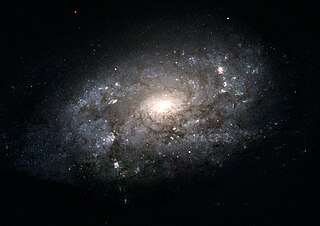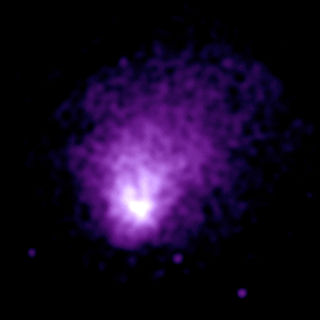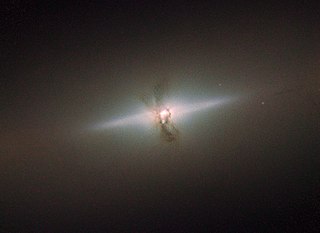Related Research Articles

The Local Group is the galaxy group that includes the Milky Way. It has a total diameter of roughly 3 megaparsecs (10 million light-years; 9×1022 metres), and a total mass of the order of 2×1012 solar masses (4×1042 kg). It consists of two collections of galaxies in a "dumbbell" shape: the Milky Way and its satellites form one lobe, and the Andromeda Galaxy and its satellites constitute the other. The two collections are separated by about 800 kpc (3×106 ly; 2×1022 m) and are moving toward one another with a velocity of 123 km/s. The group itself is a part of the larger Virgo Supercluster, which may be a part of the Laniakea Supercluster. The exact number of galaxies in the Local Group is unknown as some are occluded by the Milky Way; however, at least 80 members are known, most of which are dwarf galaxies.

A supercluster is a large group of smaller galaxy clusters or galaxy groups; they are among the largest known structures in the universe. The Milky Way is part of the Local Group galaxy group, which in turn is part of the Virgo Supercluster, which is part of the Laniakea Supercluster. The large size and low density of superclusters means that they, unlike clusters, expand with the Hubble expansion. The number of superclusters in the observable universe is estimated to be 10 million.

Chi Ursae Majoris or χ Ursae Majoris, formally named Taiyangshou, is a single star in the northern circumpolar constellation of Ursa Major. The star has an orange hue and is visible to the naked eye at night with an apparent visual magnitude of 3.72. It is located at a distance of approximately 184 light-years from the Sun based on parallax, but is drifting closer with a radial velocity of −9 km/s.

NGC 3949 is an unbarred spiral galaxy in the constellation Ursa Major. It is believed to be approximately 50 million light-years away from the Earth. NGC 3949 is a member of the M109 Group, a group of galaxies located in the constellation Ursa Major that may contain over 50 galaxies. The brightest galaxy in the group is the spiral galaxy M109.

NGC 4088 is an intermediate spiral galaxy in the constellation Ursa Major. The galaxy forms a physical pair with NGC 4085, which is located 11′ away.

NGC 4051 is an intermediate spiral galaxy in the constellation of Ursa Major. It was discovered on 6 February 1788 by John Herschel.
Ursa Major B or 3C 244.1 is a radio galaxy located in the constellation Ursa Major.
Ursa Major II Dwarf is a dwarf spheroidal galaxy situated in the Ursa Major constellation and discovered in 2006 in the data obtained by the Sloan Digital Sky Survey. The galaxy is located approximately 30 kpc from the Sun and moves towards the Sun with the velocity of about 116 km/s. It has an elliptical shape with the half-light radius of about 140 pc.

In cosmology, galaxy filaments are the largest known structures in the universe, consisting of walls of gravitationally bound galaxy superclusters. These massive, thread-like formations can reach 80 megaparsecs h−1 and form the boundaries between large voids.

Abell 665 is a galaxy cluster in the Abell catalogue in the constellation Ursa Major. It is also known as the only cluster in his 1989 catalog to receive Abell's highest richness class of 5. This means that it contains at least 300 galaxies in the magnitude range of m3 to m3+2, where m3 is the magnitude of the third-brightest member of the cluster. The clusters in all other richness classes contain less than 300 such galaxies. Abell 665's combination of high brightness and large distance, made it an excellent candidate along with 37 other clusters to help determine the Hubble constant using the Sunyaev–Zel'dovich effect in 2006.

NGC 4102 is an intermediate barred spiral galaxy located in the northern constellation of Ursa Major. It is visible in a small telescope and has an apparent visual magnitude of 11.2. The galaxy was discovered April 12, 1789 by William Herschel. J. L. E. Dreyer described it as "bright, pretty small, round, brighter middle and bright nucleus". This galaxy is located at a distance of 60 million light years and is receding with a heliocentric radial velocity of 837 km/s. It is a member of the Ursa Major group of galaxies.

NGC 5238 is an irregular galaxy in the constellation Canes Venatici. Located at a comoving distance of 4.51 Mpc, it is 64.4 arcseconds in diameter. It has sometimes been classified as a blue compact dwarf galaxy. Although some authors have hypothesized it to be a member of the M101 Group of galaxies, it is currently believed to be an isolated galaxy.

NGC 2681 is a lenticular galaxy in the constellation Ursa Major. The galaxy lies 50 million light years away from Earth, which means, given its apparent dimensions, that NGC 2681 is approximately 55,000 light years across. NGC 2681 has an active galactic nucleus and it is a type 3 Seyfert galaxy. Its nucleus is also a low-ionization nuclear emission-line region.

NGC 3191 is a barred spiral galaxy in constellation Ursa Major. It is located at a distance of circa 400 million light years from Earth, which, given its apparent dimensions, means that NGC 3191 is about 115,000 light years across. The galaxy has been distorted and interacts with a companion 1.3 armin to the west. An extremely blue tidal bridge lies between them.

NGC 4111 is a lenticular galaxy in the constellation Canes Venatici. It is located at a distance of circa 50 million light-years from Earth, which, given its apparent dimensions, means that NGC 4111 is about 55,000 light-years across. It was discovered by William Herschel in 1788. NGC 4111 possesses both thin and thick discs.

NGC 3675 is a spiral galaxy located in the constellation Ursa Major. It is located at a distance of circa 50 million light years from Earth, which, given its apparent dimensions, means that NGC 3675 is about 100,000 light years across. It was discovered by William Herschel in 1788.

NGC 4026 is an edge-on lenticular galaxy in the constellation Ursa Major. It is located at a distance of circa 50 million light years from Earth, which, given its apparent dimensions, means that NGC 4026 is about 80,000 light years across. It was discovered by William Herschel on April 12, 1789.

NGC 3726 is a spiral galaxy located in the constellation Ursa Major. It is located at a distance of circa 45 million light years from Earth, which, given its apparent dimensions, means that NGC 3726 is about 85,000 light years across. It was discovered by William Herschel on February 5, 1788.
Lynx–Ursa Major Filament is a galaxy filament. The filament is connected to and separate from the Lynx–Ursa Major Supercluster.
References
- ↑ Han, Cheongho; Gould, Andrew; Sackett, Penny D. (May 1995). "The orientation of spin vectors of galaxies in the Ursa Major filament". The Astrophysical Journal . 445, no. 1 (Part 1): 46–54. arXiv: astro-ph/9408022 . Bibcode:1995ApJ...445...46H. doi:10.1086/175671. ISSN 0004-637X. S2CID 118985923.
- ↑ The Astrophysical Journal Supplement Series, Volume 121, Issue 2, pp. 445-472. "Photometric Properties of Kiso Ultraviolet-Excess Galaxies in the Lynx-Ursa Major Region" 04/1999 Bibcode : 1999ApJS..121..445T